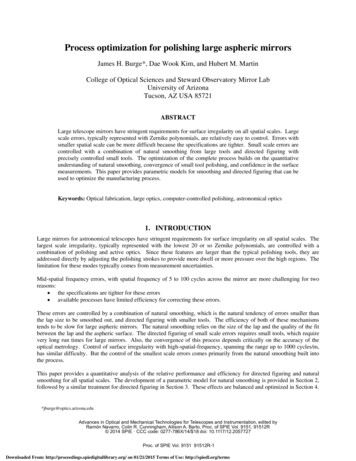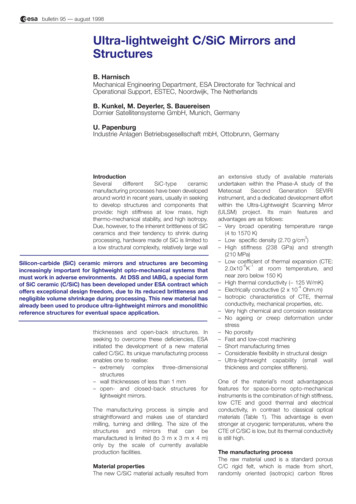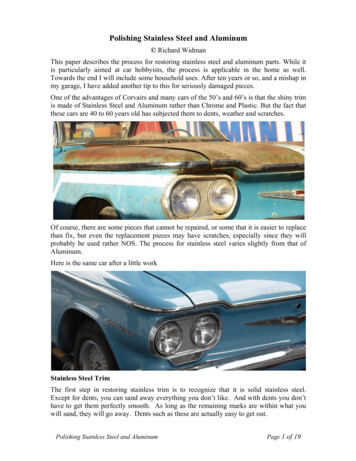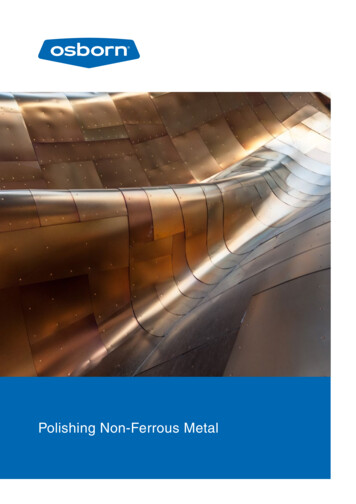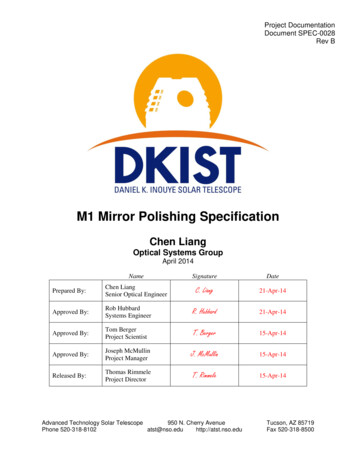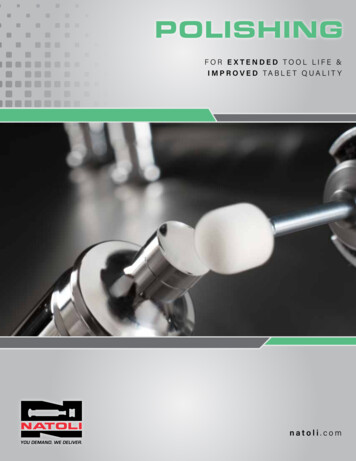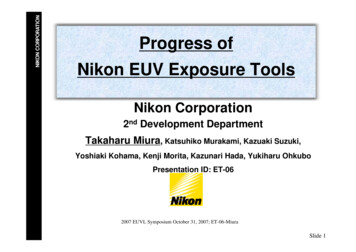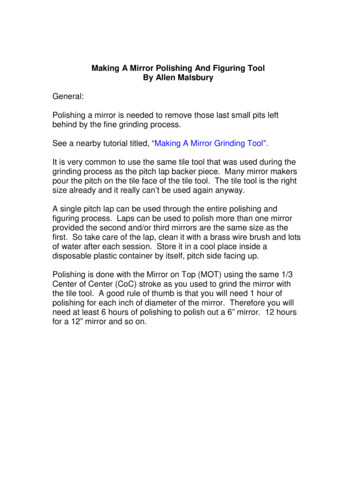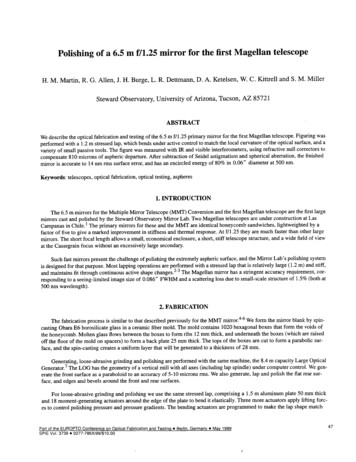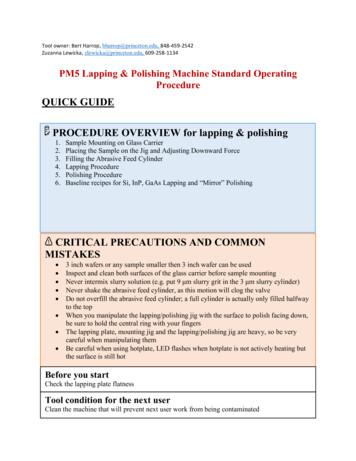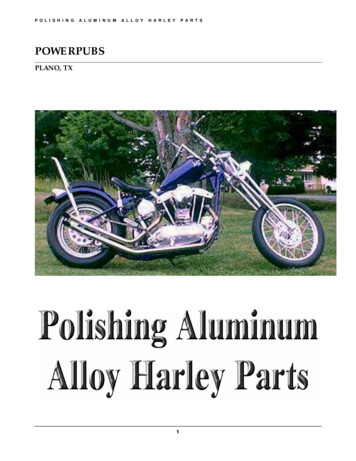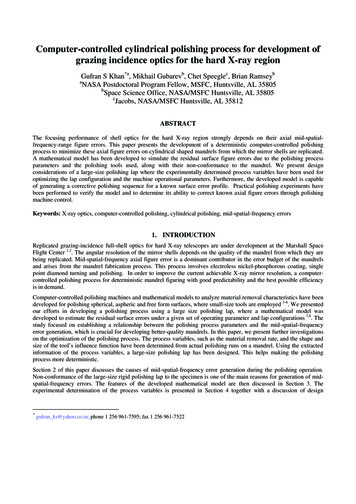
Transcription
Computer-controlled cylindrical polishing process for development ofgrazing incidence optics for the hard X-ray regionGufran S Khan*a, Mikhail Gubarevb, Chet Speeglec, Brian RamseybNASA Postdoctoral Program Fellow, MSFC, Huntsville, AL 35805bSpace Science Office, NASA/MSFC Huntsville, AL 35805cJacobs, NASA/MSFC Huntsville, AL 35812aABSTRACTThe focusing performance of shell optics for the hard X-ray region strongly depends on their axial mid-spatialfrequency-range figure errors. This paper presents the development of a deterministic computer-controlled polishingprocess to minimize these axial figure errors on cylindrical shaped mandrels from which the mirror shells are replicated.A mathematical model has been developed to simulate the residual surface figure errors due to the polishing processparameters and the polishing tools used, along with their non-conformance to the mandrel. We present designconsiderations of a large-size polishing lap where the experimentally determined process variables have been used foroptimizing the lap configuration and the machine operational parameters. Furthermore, the developed model is capableof generating a corrective polishing sequence for a known surface error profile. Practical polishing experiments havebeen performed to verify the model and to determine its ability to correct known axial figure errors through polishingmachine control.Keywords: X-ray optics, computer-controlled polishing, cylindrical polishing, mid-spatial-frequency errors1. INTRODUCTIONReplicated grazing-incidence full-shell optics for hard X-ray telescopes are under development at the Marshall SpaceFlight Center 1,2. The angular resolution of the mirror shells depends on the quality of the mandrel from which they arebeing replicated. Mid-spatial-frequency axial figure error is a dominant contributor in the error budget of the mandrelsand arises from the mandrel fabrication process. This process involves electroless nickel-phosphorous coating, singlepoint diamond turning and polishing. In order to improve the current achievable X-ray mirror resolution, a computercontrolled polishing process for deterministic mandrel figuring with good predictability and the best possible efficiencyis in demand.Computer-controlled polishing machines and mathematical models to analyze material removal characteristics have beendeveloped for polishing spherical, aspheric and free form surfaces, where small-size tools are employed 3-6. We presentedour efforts in developing a polishing process using a large size polishing lap, where a mathematical model wasdeveloped to estimate the residual surface errors under a given set of operating parameter and lap configurations 7,8. Thestudy focused on establishing a relationship between the polishing process parameters and the mid-spatial-frequencyerror generation, which is crucial for developing better-quality mandrels. In this paper, we present further investigationson the optimization of the polishing process. The process variables, such as the material removal rate, and the shape andsize of the tool’s influence function have been determined from actual polishing runs on a mandrel. Using the extractedinformation of the process variables, a large-size polishing lap has been designed. This helps making the polishingprocess more deterministic.Section 2 of this paper discusses the causes of mid-spatial-frequency error generation during the polishing operation.Non-conformance of the large-size rigid polishing lap to the specimen is one of the main reasons for generation of midspatial-frequency errors. The features of the developed mathematical model are then discussed in Section 3. Theexperimental determination of the process variables is presented in Section 4 together with a discussion of design*gufran ks@yahoo.co.in; phone 1 256 961-7595; fax 1 256 961-7522
considerations of the polishing lap configuration. Section 6 reports on the experimental tests performed to verify themodel.GENERATION OF MID-SPATIAL-FREQUENCY ERRORSThe production of mandrels has traditionally employed rigid polishing tools. However, mid-spatial-frequency errors dooften appear in the finished surface. These errors arise because of the inherent structure of the lap i.e. the shape anddistribution of tools and grooves on the lap and the polishing process parameters, as well as non-conformance betweenthe surface and the hard polishing pad.1.1 Polishing process parametersWhen a periodic structure on the lap moves back and forth on a rotating mandrel, it produces very complex mid-spatialfrequencies. The controlling process parameters are the size and shape of the individual tool on the lap, the tool-togroove ratio, and the spatial distribution of the tools over the lap surface, the length of the axial stroke, and the axial androtational speeds of the lap and the surface respectively. These parameters will control the contour path of the individualtools over the surface. Under the assumption of constant pressure and constant relative surface speed between the tooland the workpiece, the material removal depends only on the dwell position and time.1.2 Non-conformance of polishing lap to the specimenNon-conformance between the polishing lap and the optical surface is one of the main reasons for the development ofmid-spatial-frequency errors. Non-conformance arises is several ways, as discussed below:2.2.1 Mismatch of the shape of lap to the mandrel during strokeFor true cylindrical surfaces, the polishing lap remains conformed to the optical surface during the whole polishingstroke. However, if the surface to be polished is conic instead of a straight cylinder, the rigid lap cannot remainconformed to the curved/tapered surface during the whole polishing stroke. As a result, contact pressure between the tooland the workpiece becomes a dynamically changing function of time and position on the workpiece. This results in asignificant non-conformance error, the magnitude of which is dependent on the amount of taper in the mandrel.2.2.2 Existing surface error profileIn practice, the specimen to be polished has some existing surface error to start with. Traditionally, large size pitchpolishing laps are prepared by conforming them to the existing surface to be polished. The errors on the surface are thustransferred to the polishing lap during its preparation and the subsequent back and forth motion of the lap introducesnon-conformance between the local topography of the surface and the polishing lap.2.2.3 Non-uniform compliance of lap and the mandrelAt the commencement of polishing some of the individual tools in the lap do not have intimate contact with thespecimen. After some time of polishing, they gradually become in contact as pitch starts flowing due to the friction andthermal effects. However, the non-uniform compliance during this time of polishing introduces local pressure variationsleading to localized errors on the surface.2. MATHEMATICAL MODELING OF THE CYLINDRICAL POLISHING PROCESSSimulation software has been developed to predict the residual surface figure errors on a mandrel in the presence of lapnon-conformance. This simulation software enables us to establish a relationship between the polishing processparameters and the mid-spatial-frequency error generation, which is crucial for developing better-quality mandrels.The model comprises the following three features2.1 Residual mid-spatial-frequency error predictionsThe first mode of the model predicts the residual mid-spatial-frequency errors that depend on the process parameters.The process parameters modeled are the speeds of the lap and the mandrel, the tool’s influence function, the contour path(dwell) of the tools, their shape and the distribution of the tools on the polishing lap. This mode of the software has the
capability to compute the optical performance of the mandrel from its axial error profile. This ability to simulate thepolishing process permits an understanding of the dominant sources of mid-spatial-frequency errors.2.2 Optimization of process parameters and polishing lap configurationThe second mode works as an optimization routine. The optimization routine suggests a set of operating parameters andpolishing lap configuration that delivers a minimum residual error in the mid-spatial-frequency range, as determined bythe resulting mandrel figure half power diameter.2.3 Surface-error-based polishing sequenceThe third mode of the software is surface-error-based polishing sequence generation mode. It accepts an existing errorprofile and suggests a polishing sequence, where the lap configuration and the optimum process parameters aresuggested to remove the existing axial figure errors.3. DETERMINATION OF PROCESS VARIABLESA knowledge of material removal characteristics is necessary to be able to make better predictions through our model.For this, two process variables needed to be determined; the first is the material removal rate, and the second is the tool’sinfluence function. Material removal rate is the amount of material removed per unit time (in vol. or in depth) under aknown amount of pressure/weight. The influence function represents a distribution of the material removal rate acrossthe polishing tool and this has a characteristic shape and degree of symmetry. For example, if the leading edge of a toolremoves more material than the trailing edge, the influence function becomes asymmetric in shape.Experiments were designed to determine the material removal rate and the tool’s influence function under a set of knownpolishing parameters such as the applied weight, the stroke length of the polishing lap, the rotational speed of themandrel, the tool distribution on the lap, and the duration of polishing time. To gauge removal, the specimen wasmeasured on a vertical long scan trace profilometer before and after polishing runs. To acquire the precise figure of thespecimen, it was measured at four meridians 90 degrees apart. The average of the four meridians was considered arepresentative profile.3.1 Determination of material removal rateTo extract the material removal rate, one half of the specimen was polished for two hours under a set of knownoperational parameters while the other half remained unpolished. Diamond-shaped tools were selected for the polishinglap configuration. Figure 1 shows the difference between the measurements before and after the polishing. The measureddepth of material removed during the polishing operation was approximately 0.5 microns which makes the materialremoval rate 0.004 μm /min. This measurement is repeated for each different set of polishing conditions.Fig.1. Difference between height measurements before and after the polishing (before - after).3.2 Determination of tool influence functionThe influence function has been determined by performing a known set of polishing operation on a surface with knownerrors. A polishing lap comprised of four square-shaped tools was prepared as shown in Figure 2a. The tools had enoughseparation between them so that their polishing contours on the specimen did not overlap and allowed us to be able to
measure the amount of material removed by an individual tool. The polishing was performed for two hours with a strokelength of 30 mm. Figure 2b shows the difference between the measurements before and after the polishing run comparedwith simulation predictions when a step influence function is considered. The average material removed for the fourtools is shown in Figure 3a. It is clear that the assumed step influence function does not deliver a good match with theamount of material removed experimentally by the four square-shaped tools. Therefore, the influence function has beenback calculated to fit with the experimental material removal profile as shown in Figure 3b.15 x 15 mm250 mm45 mm220 mm(a)(b)Fig. 2. a) Schematic of the polishing lap with four square-shaped tools used during the polishing run for determination ofthe influence function and, (b) Difference between height measurements before and after polishing.(a)(b)Fig. 3. a) Average profile of the material removed by four square-shaped tools, (b) Match between the simulated andexperimental profile of the material removed while extracting the actual influnce function.Figure 4 shows the shape of the extracted influence function for the square tools in the axial and azimuthal directionsrespectively. It is observed that the influence functions are not symmetric in shape in the azimuthal direction. We believethat the rotational directionality of the mandrel is the main reason for this asymmetry.Fig. 4. Shape of the experimental influence function in the axialand azimuthal directions for the square tools.
3.3 Selection of polishing lap configurationThe experimentally-measured values have been fed in to the simulation software to get an optimized design for thepolishing lap and the machine operational parameters. Three types of polishing configurations, shown in Figure 5, wereinvestigated. The figure of merit used to assess these simulated runs is the mandrel figure HPD. Figure 6 compares theperformance with varying stroke length for all the three lap configurations. It was observed that equal tool-to-grooveratio with two rows of shifted tool configuration (Fig.5.b) delivered the least residual mid-spatial-frequency deviations.The optimum stroke length was found to be 30 mm.(a)(b)(c)Fig. 5. Polishing lap configuration using (a) Un-shifted square tools configuration,(b) Shifted square tool configuration, (c) Diamond tools.Fig. 6. Achievable performance in HPD vs stroke length in the case of (1)Un-shifted square toolsconfiguration, (2) Shifted square tools configuration, (3) Diamond tools configuration.5. RESULTS AND DISCUSSION5.1 Verification of the mathematical modelA series of polishing tests were conducted to verify the predictions of the mathematical model. Using inputs from thismodel, a mandrel having a conical-approximated Wolter-1 geometry has been polished using the computer-controlledcylindrical polishing machine, recently developed at MSFC. Figure 7 compares the amount of material removed duringactual polishing with that predicted.The experimental results agree with the predictions in broad terms but there are disagreements in localized regions. Theprofiles agree in terms of the generation of frequencies but there is variation in terms of their amplitudes. At present webelieve that they arise due to the non-uniformity in polishing lap compliance. Certain tools or areas of tools are either notin contact with the surface or are not applying the same pressure on the surface. Investigations are in progress todetermine the level of non-uniformity. This information will also be fed into the simulations to be able make moreaccurate predictions.
Fig. 7. Difference between height measurements before and after polishing.5.2 Generation and testing of surface error dependent polishing sequenceBased on the surface error profile of the mandrel and the prior knowledge about the material removal characteristics ofthe polishing tool, a polishing sequence has been generated and tested for one specific example. This test involves aninvestigation of the density distribution of tools on the polishing lap. Three iterative polishing experimental cycles,totaling 2 machine hrs of polishing, were performed. The goal of the experiment was to determine how well and howquickly the selected profile could be corrected. As shown in Figure 8, with 2 hrs of total polishing time the surface istaken from a profile with peak-to-valley deviation of 0.85 microns to a surface having peak-to-valley deviation of 0.2microns. The starting surface had a predicted performance of 10 arcsec while the final surface had a predictedperformance of 6 arcsec half power diameter. One can still see some residual mid-spatial-frequencies present on thesurface. In future, a few more error-based polishing sequences will be generated and experimentally implemented. It isexpected that those polishing iterations will further improve the surface figure.Fig. 8. Surface axial profiles; before and after three iterative surface-error-based polishing cycles.
CONCLUSIONSWe have developed a computer-controlled polishing process using a large-size polishing lap where experimentallydetermined process variables have been used for optimising the lap configuration and the machine operationalparameters. The experimental results have been found to be in qualitative agreement with the predictions of thesimulated model. Determinism and predictability enhances the precision in polishing and at the same time makes thewhole process cost effective. The model is capable of generating polishing sequences to correct a known surface errorprofiles. Three such polishing experiments have been performed and the results are encouraging. The information thusextracted will be used in the future for developing software for generating polishing sequences for any surface errorprofile.One of the goals of developing the polishing model is to find out the achievable limits in terms of angular resolution ofthe replicated optics being developed at the Marshall Space Flight Center, NASA. Additionally, the ability to simulatethe polishing process is an important contribution to extend automation further and thus increase the cost effectiveness ofmandrel productionACKNOWLEDGEMENTSThis research was supported by an appointment to the NASA Postdoctoral Program at the Marshall Space Flight Center,administered by Oak Ridge Associated Universities through a contract with NASA.REFERENCES[1][2][3][4][5][6][7][8]Ramsey, B. D., “Replicated nickel optics for the hard-x-ray region,” Experimental Astronomy 20, 85-92 (2005).Gubarev, M., Ramsey, B., Engelhaupt, D., and Arnold, W., “Technology Development for Nickel X-Ray OpticsEnhancement,” Proc. SPIE 7011, 7701133-7 (2008).Schinhaerl, M., Rascher, R., Stamp, R., Smith, L., Smith, G., Sperber, P., and Pitschke, E., “Utilisation of timevariant functions in the computer controlled polishing,” Prec. Eng. 32, 47-54 (2008).Walker, D. D., Brooks, D., King, A., Freeman, R., Morton, R., McCavana, G., and Kim, S-W., “The ‘Precessions’tooling for polishing and figuring flat, spherical and aspheric surfaces,” Optics Express 11, 958-964 (2003).Tuell, M. T., Burge, J. H., “Aspheric optics: smoothing the ripples with semi-flexible tools,” Opt. Eng. 41, 14731474 (2002).Schinhaerl, M., Smith, G., Stamp, R., Rascher, R., Smith, L., Pitschte, E., Sperber, P., and Geiss, A., “Mathematicalmodeling of influence functions in computer-controlled polishing: Part I,” Applied Mathematical Modelling 32,2888-2906 (2008).Khan, G. S., Gubarev, M., Arnold W., and Ramsey, B., “Development of a Computer-Controlled Polishing Processfor X-Ray Optics”, Proc SPIE 7437, 74371(2009).Khan, G.S., Gubarev, M., Speegle, C., and Ramsey, B., “Deterministic Computer-Controlled Polishing Process forHigh-Energy X-Ray Optics,” in Optical Fabrication and Testing, OSA Technical Digest (CD) (Optical Society ofAmerica, 2010), paper OThB2 (2010).
Computer-controlled cylindrical polishing process for developmentof grazing incidence optics for hard X-ray regionbyGufran Sayeed KhanNASA Postdoctoral Fellow,X-Ray Astronomy GroupMSFCHuntsville, AL 35805, USACo-authorsMikhail GubarevChet SpeegleBrian Ramsey2nd August SPIE 2010, San Diego, CA, USAHigh Energy Replicated Optics Program at MSFC
Design Considerations of Polishing Lap for ComputerControlled Cylindrical Polishing ProcessOUTLINE Grazing incidence X-Ray optics ( Replicated Ni Optics )Motivation and challengesMid spatial frequency generation in cylindrical polishingDesign considerations for polishing lapSimulation studies and experimental resultsFuture scopeSummary2nd August SPIE 2010, San Diego, CA, USA
Grazing incidence XX-Ray imaging opticsParabolicHyperbolicGrazing incidence opticsprovide high resolutionimaging at X-ray energylevelsWolter-IGeometryNested array of thin shells 0.25 mmX RaysConcentrically nested tobuild up collection areaDetectorShells are being developed by using replication approach (Electroforming)2nd August SPIE 2010, San Diego, CA, USA
Current status of replication optics technologyTypical mirror shells fabricated at MSFCangular resolution 13-15 arcsec HPDMandrel 10 arcsec HPDangular resolution 5 arcsec HPDFuture optics requirementQuality of the mandrel is the limiting factorMandrel 2 arcsec HPDMid-spatial-frequency range errors are dominant source of error on mandrel 25 mmMid-spatial-frequency errors on mandrelThese are 1-50 mm size(wavelength)Typically the amplitude of these errorsare of 100 nm scaleMid-frequency errors are inherentto the polishing process2nd August SPIE 2010, San Diego, CA, USA
Cylindrical polishing process using large size polishing lapPolishing processPolishing lap configurationApplied Force (Gravity)Large size polishing lapBack and forthaxial strokeCylindrical mandrelgroove(for slurry flow)Revolution with constantangular velocitytoolMid--spatialMidspatial--frequency range errors generationOperating parametersLap configurationMandrel rotational speedTool sizeLap axial speedTool shapeStroke lengthTool-to-groove ratioDistribution of toolsNon-conformance of lap to theNonspecimen during polishingPressure variation betweenthe tool and the specimen
Non-conformance of polishing lap to the optics (Mandrel)(A) Non-conformance due to the mismatch of the shape of lap to the mandrel during strokeDepends on Design of the optics Width of the polishing lap Stroke length during polishing(B)Non-conformance due to the surface error profileLap shape during strokeSurface profile errorDepends onAmplitude and the slope error of surface profile(C)Non-conformance during lap preparation (Practical non-conformance)Depends onEnvironmental effects
Development of Software and Polishing MachineDeveloped a software to simulate cylindrical polishing processEstablishes a relationship between the polishing process parametersand the generation of mid-spatial-frequency deviationsProcess variablesOptimization of process parameters and lap configuration to keep theresidual mid-frequency deviations to a minimumComputer-controlled polishing machine developed at NSSTCLap GuidePolishing LapMandrelHyperbolic end ofthe Mandrel
Deterministic prediction of polishingA.Determination of material removal rateAmount of material removed per unit time (in vol. or in depth) under a known amount of pressure/weightB.Determination of tool’s influence functionRemoval characteristics of the polishing toolsStepInfluence functionGaussian?C.Selection of lap configuration and stroke lengthShape, size and distribution of toolsOptimum stroke lengthAsymmetric shape
Deterministic prediction of polishingA.Determination of material removal rateAmount of material removed per unit time (in vol. or in depth) under a known amount of pressure/weight One half of the hyperbolic section of the mandrel was polished Known set of operating parameters Polishing time 2 hrs Diamond shape tools on the polishing lapMaterial removal rate 0.004 μm/min.
Deterministic prediction of polishingA.Determination of material removal rateB.Determination of tool’s influence function15 x 15 mm20.004 μm/min. Simulations are performed with step influence function45Stroke length 30 mmExtracted Influence FunctionAxial directionAzimuthal directionAmount of material removal( in microns)Amount of material removal( in microns)Amount of material removal( in microns)AverageUsing Step IF
Deterministic prediction of polishingA.Determination of material removal rateB.Determination of tool’s influence function0.004 μm/min. Axial directionSelection of lap configuration and stroke lengthUn-shifted square toolsPerformance PredictionResidual profile errorSlope errorPerformance in terms ofHalf Power DiameterShifted square toolsAzimuthal direction[Simulations]Diamond toolsPerformance in HPD (arcsec)C. Stroke length ‘mm’
Deterministic prediction of polishingA.Determination of material removal rateB.Determination of tool’s influence function0.004 μm/min. Axial directionC. Azimuthal directionSelection of lap configuration Shifted square toolsD.Stroke length2nd August SPIE 2010, San Diego, CA, USA30 mm
Polishing experiment under optimum conditionsDifference (Before polishing-After polishing)Amount of material removal( in microns)ExperimentFew months backAmount of material removal( in microns)Amount of material removal( in microns)Comparison with SimulationsPossible reasons of non-agreementNon-uniform complianceEnvironmental effectsPitch flow
Polishing experiment based on known error profileKnown Axial Error Profile
Polishing experiment based on known error profileKnown Axial Error ProfileDifference (Before polishing-After polishing)Comparison with Simulations
Future plansDetermination of non-uniformity in the polishing lap complianceDevelopment of a polishing sequence based on a known error profile ofthe specimen demonstration of the approachSoftware for generating a mandrel polishing sequenceDesign and development of a flexible polishing lapComputer controlled localized polishing process
Thank you
process to minimize these axial figure errors on cylindrical shaped mandrels from which the mirror shells are replicated. A mathematical model has been developed to simulate the residual surface figure errors due to the polishing process parameters and the polishing too
